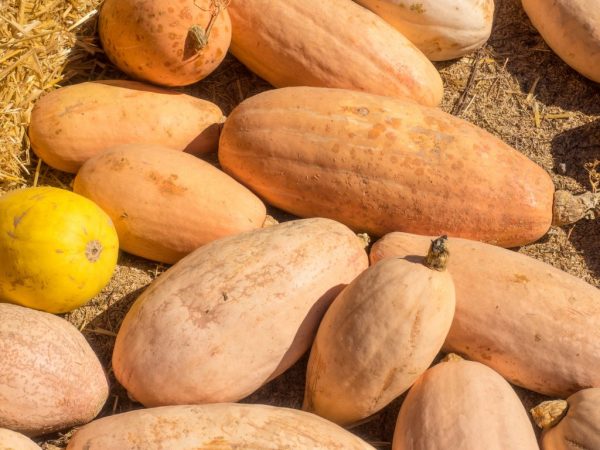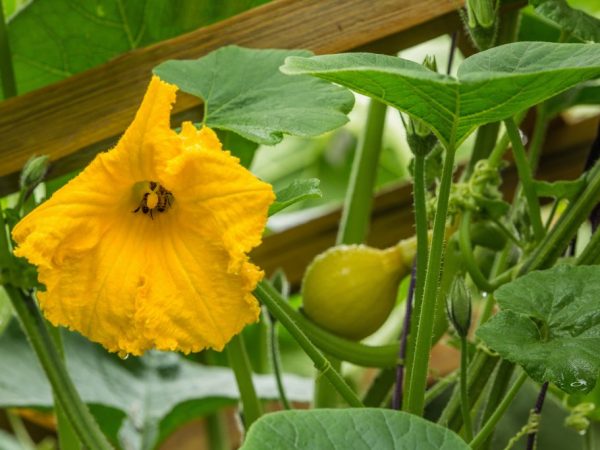Pumpkin variety Pink Banana
Each vegetable is characterized by certain properties. Pumpkin Pink banana is no exception - it will delight you with its excellent composition and cultivation characteristics. A detailed acquaintance with the variety will help to plant the crop correctly, provide the necessary care, protect against diseases, pests and collect a rich harvest.

Pumpkin variety Pink Banana
Characteristics of the variety
According to the description, the Pink Banana variety is intended for outdoor cultivation, the pumpkin has a long climbing bush that yields up to 3 fruits (11-61 kg).
The fruits reach 5 m in diameter, some of them resemble a banana in shape.
By providing the vegetable with the necessary conditions in the summer, even more fruits are tied.
Growing rules
You can get large fruits if you form a pumpkin in 2-3 lashes, while leaving up to 2 ovaries on each.
After that, the bush is limited in growth, the tops of the lashes are pinched. The formation process affects the cultivation of a compact vegetable crop, the harvest is preserved by weight without loss. The fruits are of high quality.
Landing
The growing season is 120-125 days.
Grown through seedlings and sowing seeds in open ground using shelters from a film and beds with insulation.
Seedling method
It is better to plant seeds for seedlings in early April. Planting requires care; the root system cannot be damaged.
Peat pots are suitable if abundant watering is observed 2-3 weeks after planting.
Pumpkin Pink banana is planted in fertile soil, which contains sand, humus, garden soil.
Before planting, it is recommended to soak the seeds for germination, and then they are lowered into the holes for planting in pots to a depth of 3 cm.
The containers with the planted seeds are stored at a temperature of 25 ° C, subject to the moisture content of the upper soil layer. After 2-4 days, cotyledon leaves appear on the surface. Seedling is ready for planting after 3-5 leaves appear on it.
In open ground

When the fifth leaf appears, the seedlings can be planted in the ground.
When planting seeds in the soil, they should first be germinated. They are planted in a greenhouse, which is insulated with special manure.
Arcs are placed over the insulated bed, covered with film, lutrasil. Sowing time is mid-May, but it's worth keeping an eye on the weather forecast.
Care features
Care consists in regular watering of seedlings. It should not be excessive, but the deficiency also negatively affects the growth of culture.
The soil should be filled with complex fertilizers:
- Fertika;
- Agricola with phosphorus;
- nitrogen;
- potassium;
- microelements.
Fertilizers containing potassium, phosphorus are used for feeding:
- superphosphate;
- potassium monophosphate;
- potassium sulfate;
- ready mixes.
For better growth, pumpkin must be provided with special conditions:
- moisture - its lack will lead to slow growth of fruits, they will not reach their maximum size;
- lighting - the cultivation of crops is carried out in sunny areas, preferably without wind;
- temperature - for the growth of vegetables, the optimal indicator is 25 ° C.
Harvesting and storage
At the end of the growing season, the pumpkin can be harvested. In this case, the ovaries are of different shapes, reaching 1.2 m in length.
After harvesting, fruits can be kept fresh if the rind is strong and not damaged by a fingernail.
Storage is possible until spring without loss of useful properties only if the collection rules are observed. If the fruit crust is not matured, they should be processed, their shelf life cannot exceed more than a month.
Pumpkin pests and diseases

The variety is resistant to many diseases
In Russia, conditions are quite suitable for the growth of crops in the open field.
The Pink Banana variety has resistance to many diseases that develop due to pathogenic fungi, sometimes pumpkin is susceptible to root rot or bacteriosis. Brown sores appear on the fruits, they lose their shape, curl, begin to rot.
If similar signs are detected, damaged plants should be plucked and removed from the garden, the remaining fruits are treated with Bordeaux liquid.
The presence of a spider mite, melon aphid in the beds requires constant spraying of plants with water or infusion of onion peels all day.
In order to prevent the appearance of new pests, weeds should be removed from the garden, crop rotation should be performed correctly, while the landing site changes and does not repeat for 3-4 years.
Advantages and disadvantages of the variety
The following advantages of the variety are distinguished:
- hard crust when ripe;
- excellent taste.
Disadvantages:
- exposure to some pests;
- short shelf life with an unformed crust during the ripening period.
Reviews of gardeners about this variety
According to reviews, Pink Bananas have a dense and juicy pulp, the taste of pumpkin is mildly sweet, and it also has a bright specific aroma. During the first stage of biological ripeness, it tastes like a squash.
The fruits can be eaten raw. Compliance with the rules of cultivation, taking into account the characteristics of this variety, allows gardeners to grow a lot of fruits and collect an excellent harvest at the end of the season.

